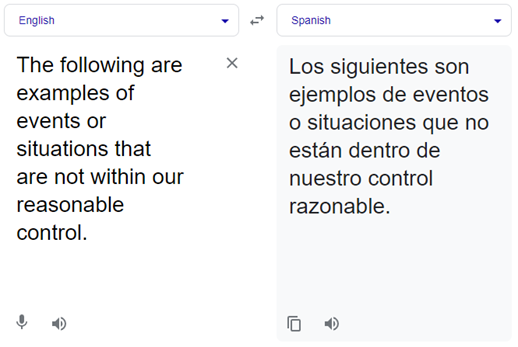
If you work in an industry that either employs or provides products and services to individuals speaking different languages, you’ll know that translation is an essential service in keeping your organisation running smoothly. You’re not alone — job opportunities in the localisation industry have grown 46 percent in the last decade. But where so many companies fall short is in how they conduct their translations.
From Google Translate to the most sophisticated machine translation software, it has never been quicker or easier to get a document translated. But while these tools can be great for quickly getting a simple idea across, where they fail mostly is in intuitive, complex communications. Luckily, humans are excellent translators — better than any machine or AI (Artificial Intelligence) on the market. Here’s why.
Comprehension is key
If you’re multilingual to any degree, you’ve likely spent some time messing about with Google Translate and chuckling when you find a mistranslation. Any word or phrase with multiple meanings (in jargon, we call this “polysemous”) can really stump machine translators, as their programming forces them to take the words individually and present the most direct and linear translation possible. Additionally, some words in Language A may have direct translations in Language B that just aren’t used in everyday language. Here’s an example using some boilerplate legal English, translated to Spanish:

Any Spanish reader would tell you that while this makes sense, it’s not really correct. This is the general impression that quick Google translations give: just a bit… weird. In linguistic jargon we call this “unidiomatic”. In more complex communications, like marketing or advertising, pieces that boast linguistic expressions or plays on words, a Google translation will hardly ever give you a satisfactory result. Any complex communication targeting any specific audience will still require a human translator who understands the intricacies of the language, culture and society of that audience to successfully translate that communication and achieve the same result.
Culture and society dictate
Machine translation largely depends on programmers, not translators, to design the systems by which it operates. As a result, these systems often lack understanding of context and cultural nuance within a document or conversation. Humans, on the other hand, are living beings, they learn, they evolve and they grow, just like societies and their languages learn, evolve and grow.
Humans are able to take in the totality of a piece of text and build their translation with that in mind, rather than working linearly like a machine does.
Also cultural consideration can be important when dealing with international businesses, and the quality, adequacy and appropriateness of a translation can make or break a deal. Human translators are able to effectively translate slang, idioms, tone, style, register, and other cultural aspects that might otherwise cause confusion or offence if translated literally or word-for-word.
Similarly, languages are always evolving, especially amongst younger age groups, and highly trained translators will know and be accustomed to always double-checking the usage of certain words within their cultural context and use them appropriately in their translation work.
Going one step further, if we consider the translation of Health & Safety guidelines or protocols the end result must be 100% accurate in order not to put lives at risk. Using AI for that purpose would be risky business, and the human translator using his expert knowledge will continue to play a key role – for quite some time yet.
Creativity inspires
Creativity and uniqueness are essential in conveying your brand messages to your audience. A machine will always be a machine, and during its mechanical translation process it will likely strip that uniqueness away, leading to bland and uniform translations that won’t capture the new audience the way the original message did.
That is where “transcreation” comes into play. Transcreation is a combination of ‘translation’ and ‘creation’, and this form of translation taps into the translator’s creativity, where, rather than a translator, his role is to be a writer, ensuring that the copy he is re-creating, is uniquely suited to the new audience, the same way the original copy was uniquely suited to the original audience.
With the right amount of creativity, human translators will keep this monopoly in translation, and we’ll be safe – for some time yet.
A Code of Ethics binds
Every professional translator is a member of a professional association and bound by its rules. For instance, in Australia, members of the Australian Institute of Interpreters and Translators (AUSIT) are bound by the following code:
- respect their clients’ rights to privacy and confidentiality
- decline to undertake work beyond their competence or accreditation levels
- take responsibility for the work of people under their supervision
- decline to mix promotional activity for clients with interpreting or translation work
- guard against misuse of inside information for personal gain
- guard against encroaching on the work of co-members
- maintain professional detachment, impartiality and objectivity
- refer to arbitration by the National Council of any dispute with other members and to accept the Council decision as binding.
This implies that professional translators are bound by a professional code and will not share any company information without the express permission of the owner of that information.
Professional translators can also sign confidentiality agreements which adds an extra layer of security. Machines unfortunately don’t offer this level of protection of information. In fact, if you agree to Google Translate’s terms and conditions (which you do implicitly whenever using the service), you are giving Google the right to “use, host, store, reproduce, modify, communicate, publish, publicly perform, publicly display and distribute content.” This is obviously unacceptable in many fields — should sensitive information like bank details, personal addresses, proprietary methods, or server information become public, it could be devastating to a company and its employees. Similarly, if Google were to glimpse a particularly innovative product that you’ve developed, and if it were to reproduce the same product and release it ahead of yours, you’d have no legal recourse, as you agreed to their terms.
If nothing else, this should be the one argument that convinces organisations to use a professional human translator over a machine even when it comes to just ‘getting the gist’ of what a document says. Running a document through Google is essentially passing up on its privacy and confidentiality. So next time you need to quickly translate a few documents, stop and think: is the speed really worth the risk?